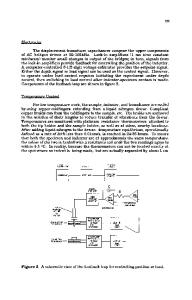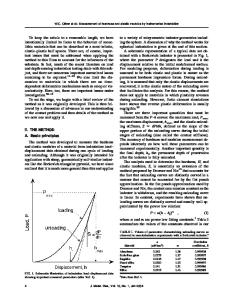Instrumentation of a conventional hardness tester for load-displacement measurement during indentation
- PDF / 565,188 Bytes
- 5 Pages / 593.28 x 841.68 pts Page_size
- 89 Downloads / 344 Views
R. R Cook IBM Thomas J. Watson Research Center, P.O. Box 218, Yorktown Heights, New York 10598 (Received 13 March 1989; accepted 28 December 1989)
A conventional microhardness tester has been instrumented with a piezoelectric load cell and capacitance displacement gages to measure load and displacement during indentation. As in other recently-developed load and displacing sensing indentation instruments, the new device can be used to measure a variety of mechanical properties, but has the advantage of being relatively inexpensive to assemble since many of its components are standard equipment. Tests were performed on soda-lime glass and an aluminum alloy, demonstrating the diversity of material elastic-plastic responses under indentation, particularly in the unloading cycle. The data suggest that models of elastic unloading based on invariant indenter-surface contact area may not be general, and may lead to underestimates of hardness and modulus. I. INTRODUCTION
Very small-scale hardness testing has recently received a great deal of attention in the materials science literature, primarily because of its potential usefulness in measuring the mechanical properties of thin films, thin surface layers, and very small volumes (for example, small precipitates or fibers).1"8 Since the indentations made using these techniques are frequently smaller than those which can be resolved optically, it has become necessary to use indirect means to determine their size, and therefore, those mechanical properties such as hardness whose measurement requires a knowledge of the indent dimensions. One popular method by which this is achieved involves the use of transducers to monitor the loads and displacements experienced by the indenter as it is driven into and withdrawn from the material. From empirically established relations for the geometry of the indenter and theoretical estimates of the elastic displacements produced during indentation, it is then possible to estimate a variety of mechanical properties directly from the experimental load-displacement curves.5'6 An equally important benefit of the technique is that it provides information which can be used in the estimation of some mechanical properties which cannot normally be determined by conventional microhardness testing, for example, the elastic modulus. Load-displacement measurement during indentation has also been found to be useful in the study of decohesion of thin films.4 To date, most of the apparatus developed to measure loads and displacements during indentation are fairly specialized and sophisticated.1"4 In addition, they typically operate at displacement rates which are much slower than those experienced in conventional microJ. Mater. Res., Vol. 5, No. 4, Apr 1990
http://journals.cambridge.org
Downloaded: 14 Feb 2015
hardness testing and are limited to low load ranges (maximum loads of —10 mN). In many cases, the specialization and sophistication are necessary, as they help to provide precision, ease of measurement, and versatility. However, this is not alway
Data Loading...










